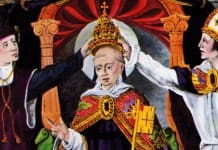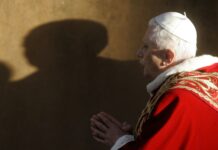Before Pope Celestine V ascended to the papacy in 1294, the Church was in a sort of “curial crisis.” Pope Nicholas IV had died in 1292, and for two years the Chair of Saint Peter was left sede vacante.
The twelve surviving cardinals (later eleven, as one died during the sede vacante) were in a deadlock, deliberating for nearly two years without reaching a consensus after the death of Nicholas IV in April of 1292.
They first balloted in Rome for 10 days, but no candidate reached a two-thirds majority. They adjourned until June, which was later extended until September after a summer epidemic in the city. After failing to elect a new pope, the non-Roman cardinals dispersed from the city, while the Roman cardinals remained.
The remaining cardinals continued balloting into the next summer of 1293 while Rome fell into disorder – palaces were razed, churches were sacked, and pilgrims were slayed. Still unable to elect a new pope, they adjourned and agreed to meet again in October at Perugia north of Rome.
In Perugia, they debated fruitlessly into the next year. By the summer of 1294, only six cardinals remained in the city. At their final meeting before they were to adjourn again, a letter was read from brother Pietro da Morrone, a Benedictine hermit known to the cardinals as a saintly figure. Morrone’s letter warned them that God revealed to him they would incur divine wrath if they did not quickly elect a pope.
After the letter was read, the Dean of the College of Cardinals Latino Orsini exclaimed: “In the name of the Father, the Son, and the Holy Ghost, I elect brother Pietro di Morrone.” The other cardinals agreed and recalled the others to Perugia to consent to the election on July 5th, 1294.
When sent for at his mountaintop hermitage, Morrone refused to accept the papacy and even tried to flee. It was only when a group of cardinals and the King of Naples Charles II came to see him that he agreed and took the name Pope Celestine V.
His coronation ceremony took place on August 29th, but since only three cardinals were present, his coronation was repeated a few days later when more had arrived in the city of L’Aquila. Known as the “Hermit Pope,” he was the only pope to be crowned twice.
The reluctant pope, Celestine V’s papacy proved ineffectual. He did however renew the papal bull Ubi periculum which made the papal conclave the standard way to elect a pope, preventing any further long periods of sede vacante. He was thus the last non-conclave elected pope in the history of the Church.
After realizing his lack of authority, personal incompatibility with papal duties, and desire to return to the life of a hermit, h consulted with Cardinal Benedetto Caetani about the possibility of resignation.
His final decree as pope was declaring the right of resignation. A week later, he exercised his right and became the first pope to formally resign the papacy. In his resignation, he cited the following reasons for doing so.
“The desire for humility, for a purer life, for a stainless conscience, the deficiencies of his own physical strength, his ignorance, the perverseness of the people, his longing for the tranquility of his former life.”
Over 700 years later, Pope Benedict XVI would become the second pope to freely exercise the right to resignation on February 28th, 2013.
Photo credit: Enrico Spetrino / Shutterstock.com


















[…] Register How the Consecration to St. Joseph can Change Your Life – Philip Kosloski at Aleteia Benedict XVI Was the Second Pope to Abdicate the Papacy, but Who Was the First? – uCatholic As the Family Goes, So Goes the Faith – Anna Abbott at National Catholic […]